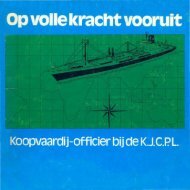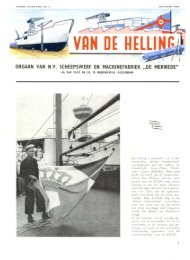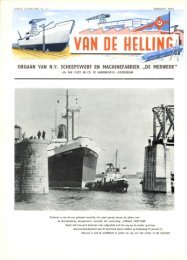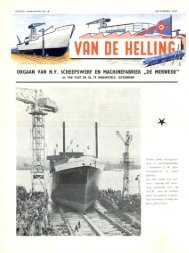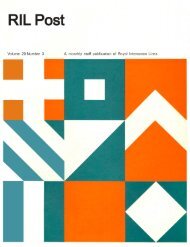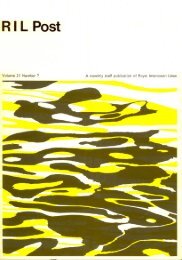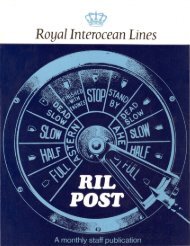Royal Interocean Lines - Varen Is Fijner
Royal Interocean Lines - Varen Is Fijner
Royal Interocean Lines - Varen Is Fijner
Create successful ePaper yourself
Turn your PDF publications into a flip-book with our unique Google optimized e-Paper software.
RIL POST<br />
Vol. XIV No. II November 1967<br />
A monthly magazine for all<br />
personnel of:<br />
ROYAL INTEROCEAN LINES<br />
(Koninklijke Java -China<br />
Paketvaart Lijnen N.Y.)<br />
N.Y. NEDERLANDSE TANI
ig which is kept in position by a number of heavy<br />
anchors on long lengths of chain. In both shallow and<br />
deeper waters, drilling is also carried out with a d rillingship<br />
which is sometimes self.propelled and which somet<br />
imes depends on towage services for change in location.<br />
The handling of semi-submersible rigs and non-propelled<br />
d rilling-vessels especially causes great operational hardship.<br />
The principal dimensions and characteristics of the $mit<br />
Lloyd supplyboats are as follows:<br />
Length overall<br />
Length b .p .<br />
Breadth<br />
Depth -<br />
Draught<br />
Deadweight<br />
G ross tonnage<br />
Free deck area -<br />
Loading capacities:<br />
cement<br />
196 ft.<br />
162 ft.<br />
38 ft.<br />
16 ft.<br />
13' 6"<br />
750 tons<br />
798 tons<br />
105 ft. X 29 ft.<br />
(in vertical tanks underdeck) - 4000 cubic feet<br />
fuel 300 tons<br />
d rill ing water 400 tons<br />
fresh water 50 tons<br />
maximum cargo on deck 400 t ons<br />
Class - American Bureau of Shipping<br />
Tw in screw, variable pitch, two rudders<br />
Main engine power 3000 HP<br />
Equipped for local towage<br />
Extensive automation and full bridge cont rol.<br />
Operating in adverse weather and in remote a reas calls<br />
for a large and powerful vessel with perfect sea-keeping<br />
ability. Carriage of bulk cement and barite should<br />
be in tanks underdeck. Ample tank capacities for oil ,<br />
drilling water and potable water are essential- especially<br />
because under storm conditions the supplyvessels<br />
may not be able to come alongside for some considerable<br />
time and every opportunity should be taken t o provide<br />
the rigs with as much needed materials as possible at<br />
a time. In other areas of the world, the distance<br />
between supplybase and rig may be very long, and in<br />
Australia this dista nce at times may well be in the region<br />
of 500 miles. Double sets of fuel and water discharging<br />
pumps ensure the reliability so evidently necessary.<br />
Apa rt f rom the economics involved when supplyboats<br />
already under contract to operators are employed in<br />
towing the dri lling rigs from location to locat ion, this<br />
becomes an absolute requirement in areas where no tugs,<br />
or not a sufficient number of tugs, are available. The<br />
"world-wide" type supplyboat must therefore have all<br />
the good qualities of a sea-going tug, manned with<br />
personnel experienced with this type of work. This,<br />
again, calls for a modern tugboat type hull form, powerfu<br />
l machinery, suitable towing winc h and- as a deviat ion<br />
from "Gulf-type" boats- an engine-room forward, so<br />
as to have t he deck completely free of obstructions such<br />
as t he aft funnels.<br />
- 205<br />
The towage of the semi-submersible rigs used in water<br />
depths of 600' requires a lot of horsepower, and two<br />
supplyboats of 3000 HP each in towing these rigs from<br />
location to location is no luxury. Inasmuch as the<br />
supplyboats are considered the marine workhorses for<br />
the offshore industry, the engines are the workhorse of<br />
the supplyboat. Especia lly designed for reliability and<br />
towage and anchorhandling work, t he Smit-Lioyd supply<br />
vessels have large, heavy, slow-speed diesel engines.<br />
These vessels use 2 lndustrie Diesel engines with an<br />
output of 1500 H P each at 300 revolutions, each engine<br />
weighing 4 2 tons. The bow thruster has become an<br />
almost indispensable unit, not only to facilitate easier<br />
manoeuvring near the rigs but to aid the vessel d ropping<br />
t he rig anchors at the exact required spot , whi lst the<br />
bow thruster is a valuable asset when towing-lines are<br />
to be connected.<br />
The handling of the anchors of the semi-submersible rigs<br />
is not to be underestimated. To successfully bring out<br />
and retrieve the 30,000 lbs Danforth anchors, 2,500'<br />
chain, cement blocks, pennant wire and buoys, heavy<br />
and reliable equipment is needed, especially as this work<br />
is now often carried out in seas of 6' high. The heavy<br />
Danforth anchors often bury themselves deeply into the<br />
ocean floor, requiring a real powerful winch to lift them.<br />
Occasionally the anchor buoys break away during bad<br />
weather: the supplyboat then has to retrieve the rig<br />
anchors by working with a chainchaser which. again,<br />
demands a supplyboat with about 30 tons bollard pull.<br />
At times, the rig anchors need to be worked over the<br />
stern of the supplyboat and, working with 30,000 lbs<br />
anchors, the conventiona l sternroller needs to be so<br />
much increased in size and strength that this almost<br />
becomes prohibitive. The risk of damage is ever present<br />
and, in remote areas, this would render the anchorhandling<br />
capacity of the vessel inefficient. Although<br />
new techniques wil l continue to be developed for this<br />
specialised work, the Smit-Lioyd vessels are equipped<br />
with a small heavy-load sternroller to guide the pennant<br />
wire, thereby avoiding chafing and breakage, whilst the<br />
roller is a splendid aid to bring the anchor buoys on<br />
deck. The cement b locks of 2!-- 3 tons, fitted in the<br />
rig anchoring system, are pulled out of the water by<br />
an specially-constructed davit on the stern, which davit<br />
can also be installed amidships. To recover the rig<br />
anchors, a portab le frame has been constructed on the<br />
stern. To be able to lower and recover a divingbell<br />
(which is now often used), a I 0 -ton derrick is fitted to<br />
one of the funnel posts.<br />
A feature of the supplyboat which is particularly favou red<br />
is the use of variable pitch propellers and at this moment<br />
the Smit-Lioyd vessels are the only ones in existence so<br />
equipped. Variable p itch propellers allow the vessel to<br />
p roceed alongside the rigs and to remain in position<br />
in high seas with the aid of the bow thruster, without<br />
anchoring or mooring, in order to deliver a much needed<br />
piece of equipment, or t o take personnel aboard. Other<br />
advantages of the variable pitch propellers are increased<br />
(continued 0 11 next page)
efficiency when towing and easier handling in the wheelhouse<br />
with visual control. Experience with variable pitch<br />
propellers has resulted in the installation of programmed<br />
cans for optimum combination of pitch and revolutions<br />
of the propellers for various conditions.<br />
A "push-button" system is also installed to facilitate<br />
maximum pitch of the propellers in a matter of a few<br />
seconds. During "crash-stop" t ri als it took less than 60<br />
seconds to make way over the stern after having gone<br />
full ahead at 13 knots.<br />
Automation is incorporated in many new vessels and,<br />
therefore, is used on the modern supplyboats to a very<br />
large extent. Notably, only the starting of the main<br />
engines and auxiliaries is done in the engine-room; all<br />
other controls a re in the wheelhouse where the emergency<br />
stops for main engines a nd cargo pumps are also situated.<br />
The Master, virtually performing a one-man show on the<br />
bridge, needs everything at his fingertips. The control<br />
panel in the wheelhouse features controls for the ancbr<br />
windlass, reversible pitch propellers, automatic steering<br />
and gyro compass, bow thruster and contains a transistorized<br />
Radar, Radio-telephone, VHF, Direction Finder,<br />
Echosounder, Decca, Loudhailer and a wide range of<br />
alarm and safety devices.<br />
The technique mainly used in the North Sea to tie up<br />
to the drilling rigs is to back up against the rig , nearly<br />
" When I saw the picture of Straat Mozambique and<br />
Houtman, tied up together in August's RIL Post, I<br />
remembered a similar photo which I am enclosing herewith.<br />
This photo was taken immediately after the launching of<br />
m.s. Houtman at Van der Ciessen's Yard in 1954. Please<br />
1954<br />
SUPPLY • BQ A TS (continued from prct••ous page)<br />
TO THE EDITOR<br />
206<br />
always making use of the bow anchors. It has been<br />
stated that the use of bow anchors on a supplyboat<br />
in one year exceeds the use of these anchors on an<br />
ocean-going freighter during her economic life, and for<br />
this reason the capacity and design of the windlass on<br />
supplyboats should leave absolutely nothing to be desired<br />
and should by far exceed Classification Rules.<br />
Special attention must be paid to the design and location<br />
of the bollards and capstans, particularly astern, in order<br />
to ensure a fast and safe mooring. for which heavy nylon<br />
ropes are often used. To be able to withstand the<br />
heaving of a supplyboat in rougher seas, the mooring<br />
system which has proved to be of good use consists of<br />
a heavy wire fastened onto a heavy nylon rope of 6-8"<br />
circumference, with a heavy ai rcraft tyre in between<br />
for elasticity. The crane boom on the rig should be<br />
sufficiently long to present the mooring ropes to the<br />
vessel without the latter having to manoeuvre too closely<br />
to the rig in rough seas. Polypropelene is also used<br />
because of its elasticity and floating characteristic, but<br />
is considered not as strong.<br />
It will be noted that the design, construction and operation<br />
of supplyboats is a difficult and complicated task.<br />
It is a relatively new industry in Dutch shipping and<br />
as such attracts a lot of attention. In spite of these<br />
complications everybody connected with the offshore<br />
exploration work finds it most interesting and rewarding.<br />
note that the position is the same: Mozambique's portside<br />
against Houtman's starboard."<br />
J. R. van Osse le n<br />
It is really an astonishing coincidence- and what a<br />
memory!<br />
1967
A n interesting arrival in the Fa r East in September was<br />
the NTPM ship SLOTERKERK , usually operated in the<br />
Holland-Africa Li ne by the VNS.<br />
As a result of the closure of the Suez Cana l,<br />
SLOTERKERK had to re place the delayed VNS ship<br />
SPAARNEKERK for one voyage in Holla nd-East Asia<br />
Line's Europe-Fa r East Express Service. This service<br />
completes the voyage from Hong Kong to Rotterdam<br />
in 29 days only!<br />
When we went on board, we were surprised and pleased<br />
to meet a n old friend- C hief Engineer M. Schaafsma<br />
- wh o re tired fro m RIL service in 1963. He emerged<br />
from his home in Bussum to ma ke this one t rip, and his<br />
beaming smile seemed to indicate that he felt very much<br />
at home.<br />
Captain T.M. Kuipers told us that it was some years<br />
since he had last seen Hong Kong- at that time o n<br />
board the tanker Westertoren- and, along with every-<br />
207<br />
SLOTERKERK<br />
SAILS EAST<br />
body else on board, he was wishing that there was more<br />
time for shopping. No doubt there were some wives<br />
with the same thought!<br />
Chief Engineer Schaafsma, Captain Kuipers and Chief Officer f.<br />
Lmneyer enjoy a l'Of/ec hrcak.<br />
ALIAS ' KEERKRING '<br />
m .v. Venice makes ready to sail from Hong Kong for<br />
Singapore on 8th September- just one day after RIL<br />
delivered her to her new owners.<br />
Other names to look out for:-<br />
KOT A NAGA - ex Sinabang<br />
KOT A SINGA - ex Siberoet<br />
KOTA TIMUR - ex Straat Malakka
MAIDEN<br />
W hen the sparkling STRAAT HOLLAND sailed into<br />
Hong Kong harbour on 6th September, there was quite<br />
an invasion by RIL staff to see and admire the design<br />
of the new ship- first of the four STRAAT H-vessels.<br />
The first su rprise was the raked stem and fine lines of<br />
the bow, doing away with the bulb which was fitted on<br />
the STRAAT F's. The arrangement of the holds, with<br />
four forward and one aft. also gave this ship a completely<br />
d ifferent appearance from her predecessors.<br />
Inspection of the vessel made it obvious right away that<br />
a utomation in RIL ships has taken several strides forward,<br />
and beaming Chief Engineer J.R. Holman was proudly<br />
demonstrating how only one duty engineer is now needed<br />
for remote control in the large 'Control Station', a selfcontained,<br />
sound-proofed room, housing the manoeuvring<br />
stand of the main and auxiliary engines, and also the<br />
main switchboard. An electronic data logger monitors<br />
the performance of all the machinery, including the<br />
ful ly-automated refrigeration plant. No-one could misunderstand<br />
the automatic ala rm system, with its noisy<br />
clangour and flashing lights. In fact, as we stood in<br />
the control room (w hich is located on E-deck at the<br />
foreside of t he main engine), and gazed with awe at<br />
the panels of colou red push-buttons and switches, the<br />
only question we could think to ask was, how does an<br />
engineer ever manage to keep up with this 'mechanism<br />
from Mars'? Smiling Mr Holman was very confident of<br />
the efficiency of the new machinery, and took us round<br />
to see the four high-speed auxiliary engines which will<br />
be overhauled by replacement, each being removed<br />
after 18,000 running hours, (through t he small shi ps-stores<br />
hatch on B-deck) for return to the makers in Holland.<br />
Up on the bridge with Captain J .Ch. Beynon, we stood<br />
at the 'bridge console', right in front, which has an<br />
automatic pilot and carries all apparatus for navigation,<br />
steering, telegraph, telephones etc. A glance over the<br />
209<br />
VOYAGE<br />
shoulder, through wide windows, showed the new b road<br />
'Webster' bridgewing, which- with a bit of trial and<br />
e rro r with life-boat fitments- will eventually give a n<br />
almost 360° view from the wheel house. All telegraph<br />
commands are registe red automatically. There is a hold<br />
temperat ure printer and a b ilge level indicator pa nel.<br />
Another item which caught our eye was the b ig electric<br />
clock, which is synchronised automatically with all the<br />
other clocks on board.<br />
Looking forward, the 20-ton electro-hydra ulic c rane<br />
between No. 3 and No. 4 holds (suitable for lifting<br />
containers) stands out . All the holds have uppe r and<br />
lower tween decks, and the p ush-button cont rol of a ll<br />
ha tch covers by o ne man at deck level certainly looked<br />
'child's play' . No. 3 hold has triple hatches, and No. 5<br />
now also has them. The latter is a raised deck, and<br />
the two side hatches can be used for ore . These a re<br />
truly multi-purpose holds: No. I lower hold is specially<br />
equipped for the carriage of ferro-silicon in bulk, and<br />
out of the total bale space of 632,000 cubic feet,<br />
refrigerated capacity is 65,000 cubic feet and liq uid<br />
capacity, 52,000. Mechanical ventilation is provided<br />
throughout, and its capacity has bee n increased in the<br />
upper tweendecks of Nos. I and 4 holds for the carriage<br />
of fruit.<br />
The fully-airconditioned interior makes pleasant living<br />
conditions for ship's personnel, and the well-fitted kitc hen<br />
must certainly be easy to work in. It serves t he one<br />
la rge crew messroom and the petty-officers' messroom<br />
on one side, and the officers' dining-room on the othe r.<br />
The individ ua l refrigerated store rooms for meat , c heese<br />
and vegetables would make a deep impression on a ny<br />
housewife.<br />
There a re no less than th ree television sets on board,<br />
and- for the first time on a RIL freighter- a wellfitted,<br />
self-service bar is provided next to the spacious<br />
( cOtllitlued 011 next page)
Souvenir prosented by the Moyer<br />
of Kobe. The ship in the foreground<br />
looks remorkobly like o<br />
BRT-type RIL vessel.<br />
'<br />
'<br />
Only one duty engineer is required in the big Control Stotion.<br />
)<br />
Coptoin Urobe, Horbour-moster of Yokohomo,<br />
presented o locquered wooden corved flower to<br />
the Moster on beholf of the Moyer.<br />
A bouquet wos presented to Cap!oin Beynon by one of<br />
Kobe's Seo Queens.<br />
Wide bndge wing.<br />
STRAAT<br />
Maide n<br />
(continued fro.<br />
officers' lounge. These t l<br />
newness at the moment, b<br />
the passing of time.<br />
Everyone on board IS 1u<br />
HOLLAND, and the vesse<br />
and faster p rogramme fo<br />
Africa-South America Serv<br />
Chief Engineer Holmon ond No. I Firemon Li<br />
Fook Toi show HO TO visitors the auxiliary<br />
engines.
Umfo lozi<br />
THROUGH ENGLISH EYES<br />
Y our Editor visits South Africa - Ill<br />
The next unforgettable day was to be the highlight of our far-tooshort<br />
South African tour. Shivering in the four-o'clock chill of on<br />
overcast morning. we clutched blankets round us in the car as we<br />
drove north, not to the well-known Hluhluwe (say 'H'shoo-shlooie')<br />
Game Reserve, but to neighbouring Umfolozi, where our driver (on<br />
e nthusiastic local resident) told us we should see many of the<br />
enormous white rhinoceros, found in very few other places. Rain<br />
started to fa ll as we drove through low scrub, past an uninspiring<br />
barbed-wire fence, until almost imperceptibly we found ourselves<br />
among trees in the hills around the Umfolozi River. At the<br />
warden's camp, we picked up a serious, armed guide, without<br />
whom we should not have been allowed to proceed. The steody<br />
drizzle was an advantage, we were told, as the animals would not<br />
be so quick to retreat to deep shade after their early morning<br />
grazing, but we should need to look very closely if we were to<br />
see anything. "Look- there!" We gazed intently at an open<br />
glade, and suddenly- magically - it was seen to be alive with<br />
red-brown duiker, sma ll antelope, which crashed away into the<br />
bushes as our exclamations shattered the morning peoce. After<br />
that, we learned to keep quiet, to point dramatically as each new<br />
animal came in sight. Moving slowly round a corner, we came<br />
upon a comic family of wart-hog, each little pig running from us<br />
with its tail pointing stiffly in the oir. In a thicket, motionless,<br />
stood a great heavy-shouldered wildebeest. A rare, silver-backed<br />
jackal slunk away up a hill. And so it went on. Sometimes several<br />
A curious young waterbuck.<br />
212<br />
miles would be covered without sight of on a nimo!, but olwoys<br />
there was keen expectation of new surprises wo iting round the next<br />
corner. A family of dog-faced baboons amused us for some time<br />
with their antics, and motherly guineafowl continually delighted us<br />
with their unconcerned clucking to baby balls of fluff.<br />
We hod the Reserve almost to ourselves on that late Summer<br />
morning, and soon learned to pick out what for the most part<br />
were unfrightened an ima ls. Car engines were a fam iliar sound to<br />
them and they on ly stirred when the vehicles stopped too abruptly.<br />
It d,d str1ke us that Umfolozi might be overstocked with deer, b ut<br />
we were told that a new p ride of lions has just been introduced,<br />
so no doubt there wi ll be o quick reodjustment. Some of the fat<br />
zebra which we saw in the distance will also have to keep a sharp<br />
look-out.<br />
The rain eased as we turned off to o large waterhole, a perfect<br />
ploce for the packed breokfost which we attacked with gusto.<br />
Under a warming sun, we lazed on the flat rocks, sipping hot<br />
coffee as we watched dozens of small turtles beneath us. Pieces<br />
of bread thrown down enticed them to struggle out with p rodigious<br />
clumsy effort, climbing over each other in their eogerness before<br />
falling back into their natural element.<br />
We were now showered with earnest instructions: "You will be<br />
allowed out of the car when the rhino are seen, but you must<br />
keep behind the guide". "They are usually very docile, but if one<br />
charges, climb the nearest tree . . .. " I looked dubiously, both a t<br />
slender scrub and immense branchless boles, and mentally calculated<br />
how many years had elapsed since I lost climbed o tree. No<br />
doubt, fear would lend the necessary impetus.<br />
We returned to the jo lting d irt rood. A great bore potch of<br />
earth w11s pointed out to us: "Th11t's where they like to w11llow."<br />
And then- only o few yards further- "Look!" There she was,<br />
four tons of mother rhino with her baby (o mere one and o half<br />
tons) beside her. Her huge two-horned heod wos down ond her<br />
square lips were eagerly snotching at the grass. What a chomp!<br />
Each greedy mouthful seemed to clear about a foot of ground,<br />
and the young one was not doing badly either. In on owed<br />
si lence, we listened to the steody chewing until a whispered invitation<br />
led us to creep out of the car and- well behi nd the guide<br />
-we started to stalk the short-sighted behemoths. As we tiptoed<br />
up behind them, I was not the only one who nervously calculated<br />
the distance to the nearest lone tree. It might have been quite<br />
a scramble!<br />
At o peremptory gesture from our guide, we stopped to toke our<br />
photographs, and as the sma ll clicks sounded, both animals swept<br />
round and galloped clumsily away. They were not wh ite at all,<br />
more o dark grey colour, but undeniably formidable, and the fifty<br />
yards or so which had separated us had not been too much for<br />
me. Our suppressed excitement was let out in sighs of relief.
This mig ht be o commonplece in Zululend, but it wes what<br />
we ho d come to see in A frice, llnd the experience was<br />
unforgettoble.<br />
Leter, we sow dozens of white rhino, some close to the rood<br />
ond others ot o distence, end our comeros were constont ly<br />
in use, but it become obvious thot o telescopic lens is o must<br />
for o reolly serious photogropher of wild onimels. Even the<br />
boldest will not stond still for very long ot close ronge. A<br />
delightful exception wes the leggy young weterbuck who<br />
wobbled olong one stretch of the rood in front of us. His<br />
noive curiosity led him to stop end goze big-eyed ot the<br />
four-wheeled epperition behind him, ignoring the frontic<br />
bounds and cries of his enxious mother, end we were oble<br />
to wolk right up end toke oil the pictures we required.<br />
The end of the morning wos hot, steomy end full of flies,<br />
but the miles bock to Mtubetubo were soon covered os we<br />
tolked eogerly of whet we hod seen. The some ofternoon we<br />
climbed into our host's privote plene for o low flight over the<br />
estuory Ill St. Lucill . The shllrp-eyed ceught brief glimpses of<br />
crocodiles slithering off sendbenks into the wilier llS we swooped<br />
overhead, llnd we ell SllW the moss of hippopotemus in a deep<br />
pool upstrellm. The oerill l view showed us 11lso the magnificent<br />
beoches, but there were only a few offshore fishermen on the<br />
white sands. It is ll pity that sharks forbid whet would otherwise<br />
be magnificent swimming opportunities.<br />
Durban<br />
The some observetion occurred to us llgoin next morning as we<br />
flew bock in ll smell Cessno plone to Durben. Our suger ple nter<br />
pilot tolked of South Africo"s chMces egeinst Englend in the Test<br />
cricket match sterling thet dlly, but our eyes were f11stened on<br />
the coastline. I looked with more-thon-usulll interest Ill Richerd's<br />
Blly, some I 00 miles north of Durban, which is destined to be<br />
Notol's second port (RIL Post, August, 1965). The sondbanks in<br />
the shollow logoon indicote thot there will h11ve to be a vast<br />
llmount of dredging when the work gets under woy.<br />
Circling over the city. we Sllw the slreom of cers converging on<br />
Durbon"s cricket ground, ond loter, t he long queues of men ond<br />
boys outside the entrMce g11tes gave us some idee of mosculine<br />
sporting interests.<br />
It seemed odd in such e brief spoce of time to exchenge untllmed<br />
country for the sophisticetion of DurbllR. We took odvontage of<br />
our Ills! port of cell to make the usual tourist purcheses: a few<br />
smo ll samples of netive work for the children, lln e lephant-hair<br />
brecelet, a copper kudu pleque, and- rether more om bilious-a<br />
Iorge circular rug of springbok skins.<br />
Our ship wos in hMbour, but before boerding her, of course, I hod<br />
to soy hello to oil the Durbon RIL"ers. Mr Egberink ond Mr VllR<br />
Middelkoop were llwoy on e tour, but Mr von RMdwyck welcomed<br />
us, and I wlls heppy to be introduced by Mrs Hvistendohl to oil<br />
those friendly people, reserving a specially worm greeting for<br />
Correspondent Govin Forsyth. There were mMy well-known f11ces,<br />
end m11ny others mode f11milier from past photos, so thot I lllmost<br />
felt I knew everyone olreody.<br />
Finolly, we boorded STRAAT BANKA, ond in the lote afternoon<br />
we leened over the roil to welch the Windsor Cestle leeve port.<br />
Our minds were full of the things we hod experienced in the<br />
Tronsvool, 'South-West', C11pe Province Md Nlltlll. We regretted<br />
thllt we h11d not seen the Orenge Free Stole (Hop Vrijstoot!) Md<br />
thot we had not hod o fer fer longer tour, but we recoiled with<br />
deepest grotitude our generous friendly hosts Md the innumer11 ble<br />
goy, rel11xed p11rlies et which we had telked ourselves hoorse.<br />
We looked bock to the time given up to us by men with long.<br />
herdworking doys, to their lively and intelligent wives, to the strong<br />
sense of family unity which we had felt in every welcoming home,<br />
end to the heolthy, berefooted children (quite e little shock to<br />
germ-conscious Hong Kong dwellers). Above oil else, we hod<br />
enjoyed the neturel beeuties, the rugged scenery, the weolth of<br />
wild Mimals end the feeling of freedom in the wide open spoces.<br />
As we hod soid over end over ogoin in the previous two weeks.<br />
we now reiteroted to eoch other, "We must come bock." Tot<br />
siens, South Africe !<br />
213<br />
Straat Banko alongside the Passenger Terminal in Durban .<br />
Shallotvs of Hichards Bay.<br />
Windsor Castle, seen from the rat/ of Straat /Janka.
OG BOOK<br />
A-GO GO CAPTAIN!<br />
The dress is certa inly<br />
not 'mod' but the earrings<br />
undoubtedly must<br />
be 'rocker'.<br />
Captain R. Jungeling<br />
enjoys a party night<br />
on board Tegelberg.<br />
Weddings<br />
4th Officer F.C. Leliard (leave) to Miss J.D. How on 31st August<br />
at Breda.<br />
Chief Officer F. van der Linde n (leave} to Miss T. Nieveen on<br />
22nd Septembe r at Oosterbeek.<br />
4th Engineer Jac. van Doorne (leave} to Miss van Alten on 5th<br />
October at Goes.<br />
4th Officer G .J . van den Berg (leave} to Miss R. Remeeus on<br />
6th October at Vlissingen.<br />
5th Engineer R.W.P. Netto (le ave) to Miss J.M. de Witte on 9th<br />
October at Vlissingen.<br />
New Arrivals<br />
Mr R.J. Jonkhoff (Sydney, CD): a son, Michae l Ralph, on 14th July.<br />
Mr Mok Shun Kit ( H K HO Stores) : a daughter, Fung Yee, on<br />
21st August.<br />
In June, we reported that the H.V.M. ship. HOLLAN DS<br />
DREEF. had been time-chartered for one trip from Japan<br />
to Mombasa, to lift 125 railway wagons.<br />
When the bogies, sides, frames and doors were loaded<br />
at ltozaki Wha rf, very exacting a rrangements had to<br />
be made fo r the heavy load, but a ll d ifficulties were<br />
Loading Jramu from tl1e narrow wharf.<br />
FAMILY NEWS<br />
SPECIAL CHARTER<br />
" I LIKE IT "<br />
T he look of ecstasy on his face must certainly mean<br />
mo re than usual en joyment ! What can 'IT' be?<br />
When Second Officer B. Anthonissen of STRAA T<br />
C HATHA M sent this photo of "our beloved fourth<br />
mate, Mr H. van de Beek", it was in reply to our plea<br />
for more news and pictures from seagoing staff, and all<br />
that came with it was this short title.<br />
Could 'IT' be Payday? The next meal? We invite you<br />
to give your guess as to what Mr van de Beek's 'IT' can<br />
be, or alte rnatively your own vers ion of "Happiness is" ,<br />
within the framework of Company life. A small token<br />
will be sent to the author of each published definition.<br />
4th Engineer H . van Brug {leave) : a daughte r, Elisabeth Maria,<br />
on 29th August.<br />
Chief Officer H .W. louet Feisser (leave}: a son, John Herbert,<br />
on 4th September.<br />
Mr S. Fujihira (Yokohama Ag.): a daug hter, Ak iko, on 17th<br />
September.<br />
4th Officer F. van Akke ren ( leave} : a daughter, C laudia, on 19th<br />
September.<br />
3rd Engineer F.W .M. van Vliet (leave}: a son, Emil Tadao Franciscus,<br />
on 22nd September.<br />
Chief Officer E. van luyk (Sa bang) : a son, Elmer Bjorn, on 23rd<br />
September.<br />
2nd Office r W.H.C. Wijnhorst (le ave): a daughter, H endrika<br />
Carolina, on 27th September.<br />
eventually smoothed out wi th the good cooperation of<br />
the ship's staff, stevedores (Yokomi U nyu), shippers<br />
(Marubeni) and the makers (Mitsubishi). Port Captain<br />
Y. Komori (Kobe) reported that a very successful luncheon<br />
party was held on board to celebrate the completion<br />
of the operation.
FAREWELL TO<br />
CHIEF ENGINEER D. SNIP<br />
Mr van Randtll}'l'k, Chief Engineer Snip and Captain Bmin.<br />
(Ph ow: counc>y o{ The Daily News)<br />
"T he handing over of an engine-room occurs many times<br />
in our company, but when Mr Snip hands over to Mr<br />
T amboer tomorrow, it will have a special significance,<br />
as it will be the last time Mr Snip hands over an engineroom"<br />
said Mr Van Randwyck, Deputy General Manager<br />
for Africa, when he was addressing the gathering of the<br />
Straat Madura officers and Durban Management at Mr<br />
Snip's farewell lun.cheon, held on board the Straat Madura<br />
on the 26th September.<br />
Mr Van Randwyck, speaking on behalf of the Managing<br />
Directors, made reference to Mr Snip's 37 yea rs at sea,<br />
how he had joined the K.P.M. in Djakarta, serving on<br />
the small ships, his service through the war years, and<br />
how after the war his promotion came, as did also the<br />
larger vessels. Mr Snip could feel satisfied that his job<br />
had been well done and Mr Van Randwyck wished him<br />
well in his retirement.<br />
Captain J. Bruin, speaking on behalf of those who sailed<br />
with Mr Snip on the Straat Madura, thanked him for<br />
his guiding hand and presented him with a barometer<br />
with best wishes for his retirement from the Straat<br />
Madura, hoping that his "engines may run at a full speed<br />
ahead for many years to come".<br />
In his reply, Mr Snip looked back on his years at sea<br />
and how he had watched the Company grow from the<br />
small vessels he had served on in Indonesia, to the<br />
"combination" vessels and the Company as we know it<br />
today. Although he had had his ups and downs, and<br />
would have preferred to spend more time at home, he<br />
had loved the sea. He thanked the Straat Madura for<br />
his present and concluded by wishing all in the Company<br />
well.<br />
After the speeches the gathering enjoyed an excellent<br />
buffet lunch, very ably prepared by the Chief Steward<br />
Mr Mak Kam Kwong and the Chief Cook, Mr Choi Sing.<br />
- 217<br />
SHIPS O F THE WEEK<br />
Relatives of officers on board STRAA T FRAZER (top),<br />
STRAA T CLEMENT and T J IT JALENGKA (bottom) went<br />
to Hilversu m to record their messages to the ships.<br />
These were broadcast on 8th September by Radio<br />
Nederland, and at that time STRAAT FRAZER was at<br />
Lagos, STRAAT CLEMENT at Sydney, and TJITJA<br />
LENGKA in the South Atlantic on her way to South<br />
America.<br />
...
' I<br />
NEW PERSONNEL<br />
PERSONNEL<br />
A hearty we lcome is extended to the following new RIL<br />
personnel who recently took up em ployment :<br />
Mr J. Katsman<br />
,, von Dapperen<br />
.. W. Dijkstro<br />
.. Meijer<br />
.. C.J. Feith<br />
4th Officer<br />
A ppr. Engineer<br />
Employe<br />
SUCCESSFUL EXAMINATIONS<br />
Our congratulations go to the following officers, who<br />
passed examinations as indicated below:<br />
Mr J .C . Koomen<br />
H. Blok<br />
F.L. Laanen<br />
F.J. v.d. Westen<br />
LEAVE<br />
3rd Engineer<br />
5th<br />
The following perso nnel went on leave:<br />
Mr F.G . van Amersfoorth<br />
.. R. Edsen<br />
.. K.P.C .A. Gramberg<br />
.. J .L. Nobels<br />
.. H.J.J. Kessenich<br />
.. H.J. Minderhoud<br />
.. F.E. Roelofsma<br />
,. K.J . van der Veer<br />
.. A.F. Kuiper<br />
,. P.G. Langeveld<br />
,. H .K.Ch.B. Veenhuysen<br />
.. S. P. Vermeer<br />
.. W.A. von Erk<br />
.. G .J . den Hollander<br />
F. van Woerkom<br />
.. D.W.J.B. van Hattem<br />
.. R. E. Boom<br />
.. R. Kruger<br />
,. H .W .M. Veugelers<br />
.. H.J. Arends<br />
.. H. Fokkema<br />
.. G. Gerritsen<br />
.. U. Jetten<br />
.. H.D. Kwaytaal<br />
.. A.H.A.M. von Laerhoven<br />
.. J.R.W. Mouthoan<br />
.. H.J.H. Offermans<br />
.. B.D. Planting<br />
.. C .D. Roelse<br />
.. R.P. Wiegman<br />
.. J. Boone<br />
.. S. Bennemo<br />
Chief Officer<br />
2nd<br />
3rd<br />
4t h<br />
2nd Engineer<br />
3rd<br />
4th<br />
5th<br />
.. "<br />
H. Employe<br />
B<br />
A<br />
A<br />
A<br />
12·9· 1967<br />
8-9- 1967<br />
25-5·1 967<br />
24-5- 1967<br />
218<br />
-----:::.-<br />
- --<br />
Th ose who return ed are:<br />
Mr J .A. von Beurden<br />
.. P. Cox<br />
R.L. Hessel<br />
P. Maas<br />
A . T reffers<br />
P.D. A lgra<br />
H .L. Brandes<br />
M .F. Spiessens<br />
B.H. Verseput<br />
P.E. D. Beretta<br />
W. de Best<br />
P.J . Engels<br />
K. de Ru<br />
,. J. Craamer<br />
.. G .L. Dekker<br />
.. L. Dekkers<br />
C.F.H.G .M. van den<br />
Goorbergh<br />
.. D. Werner<br />
J. W esselius<br />
G .H . Dijk<br />
B.J. Koolenbrander<br />
.. R.J. Pieneman<br />
,. G .S. Scheepmaker<br />
.. J .A. Vugts<br />
.. W.K. Mink<br />
.. N. Stijve<br />
.. R.J. Thesen Ender<br />
.. J .M . Feringa<br />
.. H .K. van der Schatte<br />
Olivier<br />
.. H .M.R. Banens<br />
Ch. Officer<br />
2nd<br />
4th<br />
2nd Eng ineer<br />
3rd<br />
4th<br />
5th<br />
Adj. Chef<br />
H. Employe<br />
Employe<br />
TRANSFERS OF CAPTAINS<br />
AND CHIEF ENGINEERS<br />
posted to<br />
m.s. Str. Le Maire<br />
Str. Florida<br />
Str. Madura<br />
.. Tjitarum<br />
Str. Singapore<br />
Str. Clement<br />
Str. Madu ra<br />
Str. Rio<br />
Str. Lagos<br />
Str. Banka<br />
Str. Chatham<br />
Van Riebeeck<br />
Str. Magelhaen<br />
,. Str. Madura<br />
.. Tjitarum<br />
Str. Frazer<br />
Str. Colombo<br />
Str. Lombok<br />
Boissevain<br />
Str. Fushimi<br />
Str. Lombok<br />
.. Str. Mozambiq ue<br />
Str. Chatham<br />
Tegelberg<br />
HK M H<br />
HK HO<br />
Buenos A ires<br />
HK H O<br />
Lagos<br />
Durban<br />
Captain Th. Rose was posted to m.v. BOISSEVAIN following home<br />
leave.<br />
Captain H. M uys. Moster of m.v. BOISSEVAIN, was posted to<br />
m.v. STRAAT CUMBERLAND .<br />
Captain W. Mieog, Master of m.v. STRAAT CUMBERLAND. went<br />
on intermediate lea ve.<br />
Captain B.H. Niessen was posted to m.v. ST RAAT FRAZER fol lowing<br />
home leave.<br />
Captain G. van der Spoel, Master of m.v. STRAAT FRAZER, went<br />
on home leave.<br />
Captain G .P. Proper, Master of m.v. SIGLI, wa s posted to m.v .<br />
STRAAT LUZON.<br />
Captain J .H. van Dijk. Master of m.v. STRAAT LUZON , went on<br />
home leave .<br />
Chief Officer A.M. Frigga of m.v. ST RAAT CU MBER LAND was<br />
posted to m.v. SIGLI as Actin g Captain .<br />
Captain F.W. Kapti jn was posted to s.s. TJIKAMPEK following<br />
intermediate leave.<br />
Captain R.E.J . von Dijk, Master of s.s. TJIKAMPEK , went on home<br />
leave.<br />
Captain W.C. Bouter was posted to m.v. STRAAT C HATHAM<br />
follow ing home leave.
'OLUME 14 No. 11



